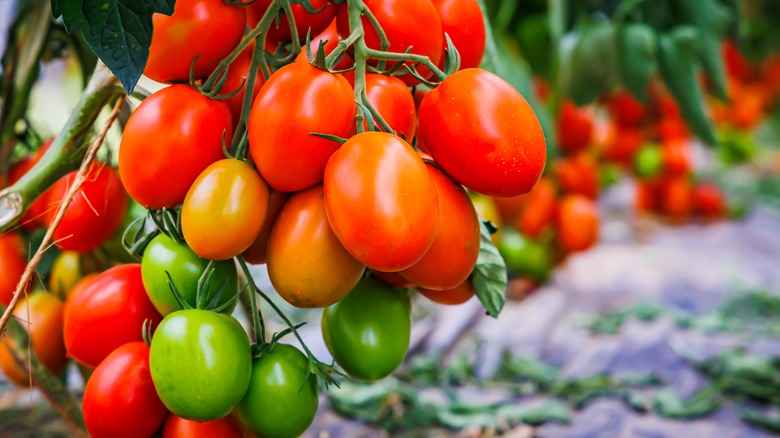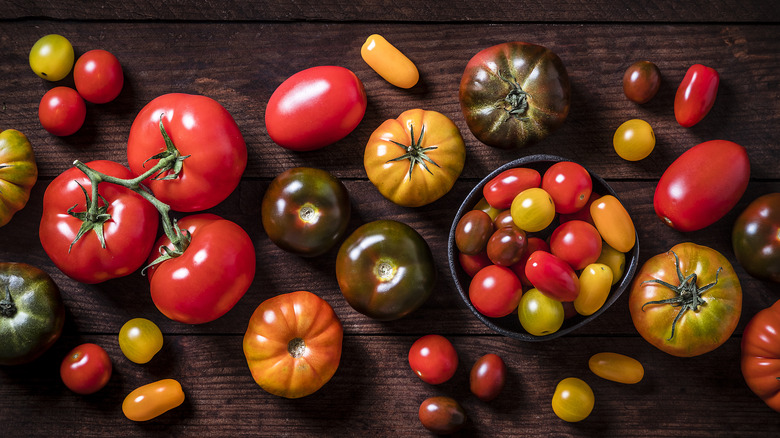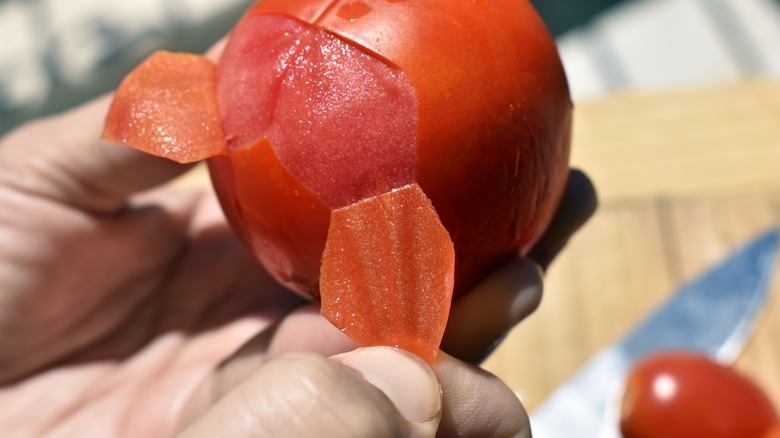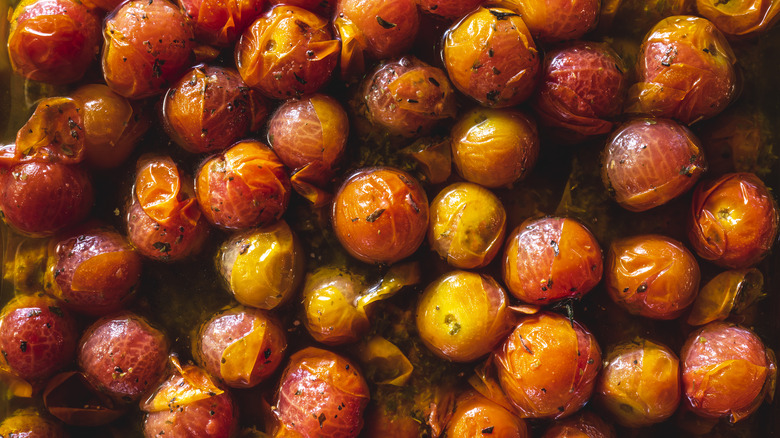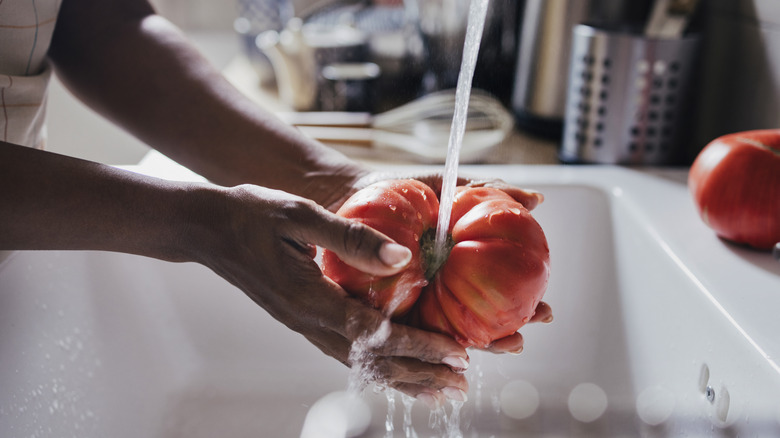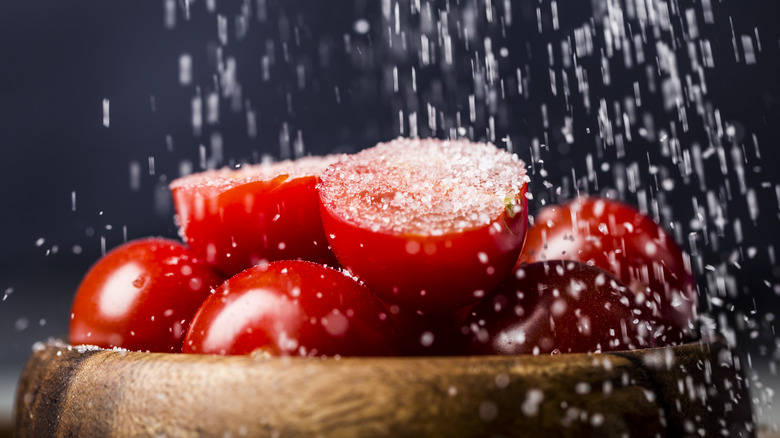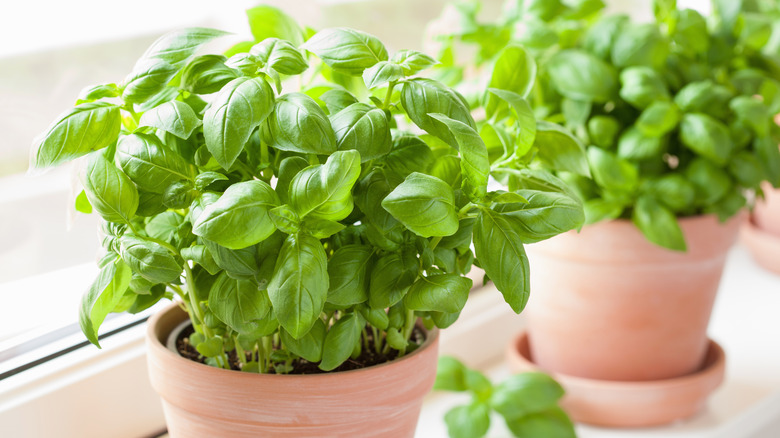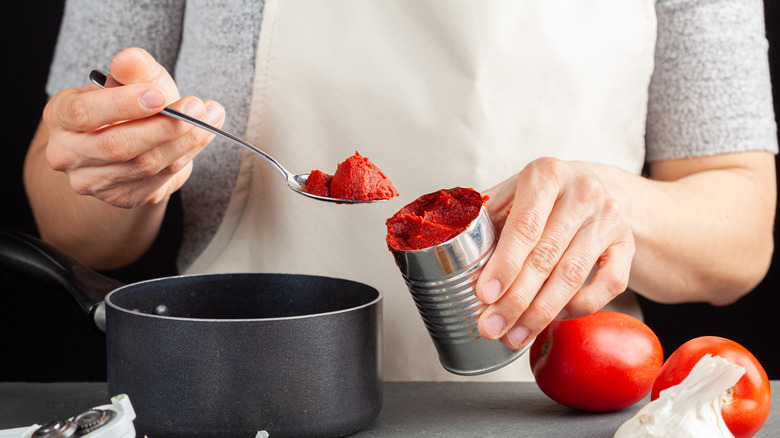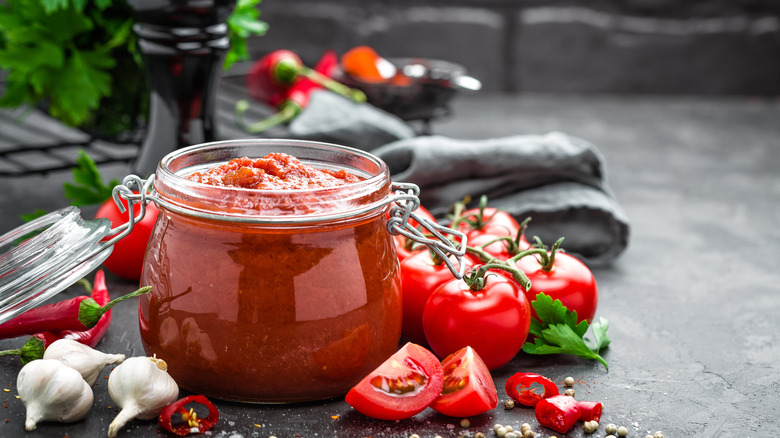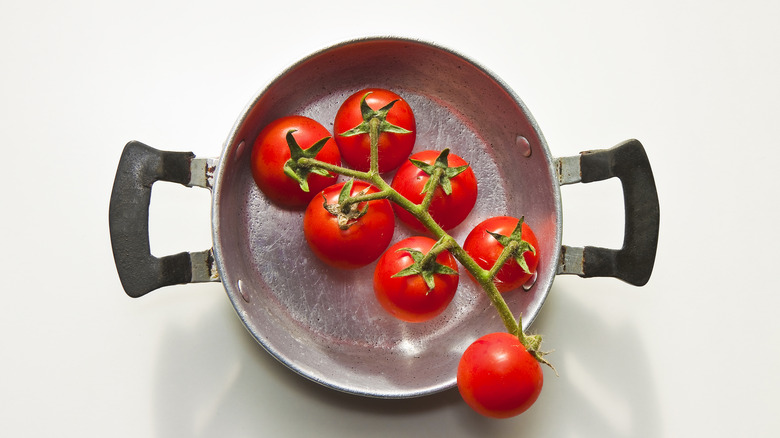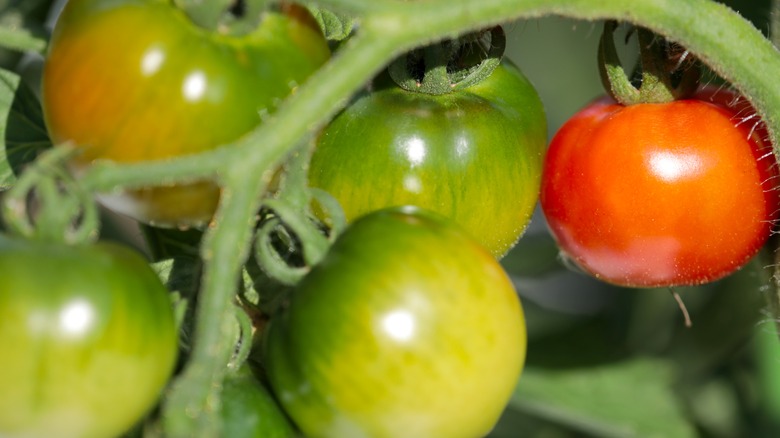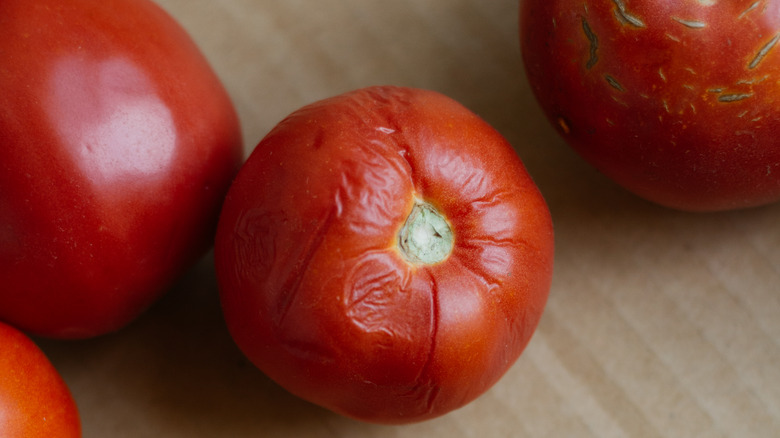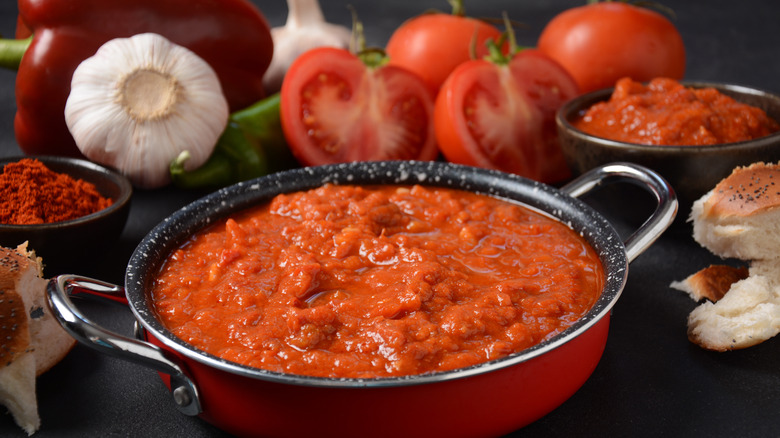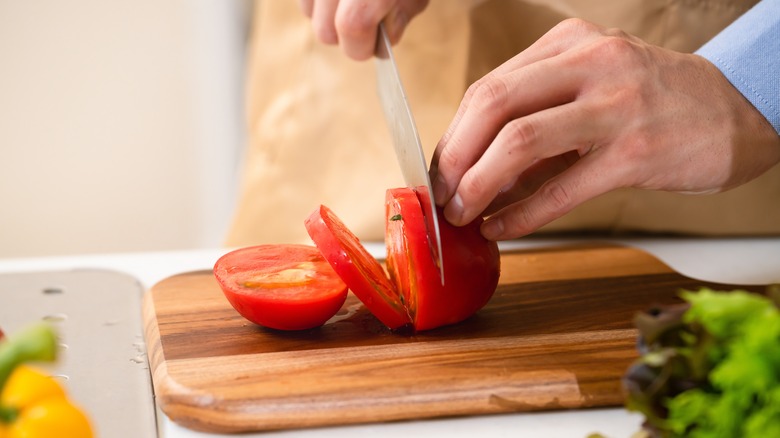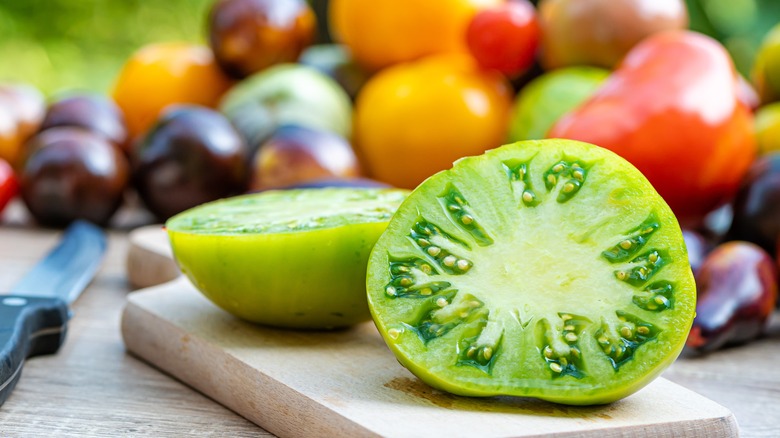Mistakes Everyone Makes When Cooking With Tomatoes
Tomatoes are a mainstay in almost every kitchen, featuring in staples as varied as marinara sauce and BLT sandwiches. Though technically a fruit, they are used almost exclusively in savory dishes with a versatile nature that pairs well with many ingredients. As common as tomatoes are, though, there are still many mistakes that even seasoned home cooks make when cooking with this delicious ingredient.
Join us as we explore the pitfalls of cooking with tomatoes, from selecting the wrong type for your dish to using incorrect cookware or not seasoning them properly. Understanding these mistakes and learning how to remedy them will take your tomato dishes from acceptable to downright delicious and help you make the most of this precious ingredient. Never again will you choose an inappropriate variety, cut it with the wrong knife, or end up with an unbalanced dish. Armed with the correct knowledge, you can make it your mission to get the best results from your tomatoes every single time.
Choosing the wrong type of tomatoes
Despite how wonderful tomatoes are in general, using the same variety every time is not the best way to use them. By sticking with what you know, you're missing out on a brilliant variety of tomatoes that can provide interesting textures and flavors to your dishes. While you could technically interchange your baby plums for your beefsteaks, you would be doing these beautiful ingredients a huge disservice.
When making a dish featuring raw tomatoes, such as a caprese salad, you want to use a tomato that makes a big impact. Beefsteak or heirloom tomatoes are a great choice, their large slices complementing the mozzarella to create a visually impressive dish. These large tomatoes also work well on a juicy burger or roasted whole alongside a steak. For other salad dishes, small sweet tomatoes work really well alongside other vegetables. Cherry or grape tomatoes offer the perfect balance of sweet and acidic and come in various colors. Sungold tomatoes, in particular, will give the plate a striking flash of orange.
If you're cooking tomatoes for a sauce or casserole, Roma tomatoes are the best option. They don't contain many seeds or much water, meaning they won't dilute the other flavors. No matter what culinary tomato creation you are planning, there will be a perfect variety out there for it. Taking some time to buy the best kind will ensure your dish has the best possible texture and a vibrant taste.
Not removing the skin
To peel or not to peel — that is definitely the question when it comes to cooking with tomatoes. The answer will depend on what you're making and your personal preferences, but if you want a perfectly smooth sauce or soup, peeling is the best option.
Peeling tomatoes is not as difficult or time-consuming as you may think, especially if you blanch them first. Blanching means cooking vegetables quickly in boiling water, then cooling them down straight away. It's a handy technique that can be used to cook tender veggies such as asparagus without losing their color or texture. In the case of tomatoes, blanching causes the skin to split and separate from the flesh, allowing you to peel them easily.
Peeling your tomatoes before cooking means you won't come across chunks of skin in your smooth sauce once the tomatoes have broken down; this is essential if you're cooking for others and want to impress. For raw dishes such as salads and salsa, most people will expect the skins to stay on in those situations.
Overcrowding the pan when roasting tomatoes
If you've never made a dish with roasted tomatoes, you're in for a treat. Roasting tomatoes intensifies the flavor and gives them a deep, rich taste that you can use to enhance your dishes. It's important to give the tomatoes plenty of space on the tray, to ensure you get the best possible flavor. When you roast tomatoes in the oven, the sugar begins to caramelize, enhancing the already sweet flavor within and removing any acidity. If the tomatoes are too crowded in the baking dish, however, they will steam instead of roasting, meaning they will not caramelize properly.
Once your tomatoes are roasted, they can be used as they are — for example, in a salad or alongside steamed fish — or they can be turned into a rich sauce. Giving them enough space in the baking tray to roast beautifully will be worth it for the deep flavor of the finished dish.
Failing to wash your tomatoes
Washing your tomatoes before you use them may seem like an unnecessary step, but it's a crucial one, especially if you're eating them raw. Fruits and vegetables can carry numerous dangerous substances that you're unable to see yet definitely don't want making their way into your body. At the very least, you should soak your tomatoes in a bowl of water for five minutes, before rinsing them thoroughly under the tap. This will help remove dirt and debris, as well as lower the number of potentially dangerous microorganisms. Another option is to wash your tomatoes in a 1:3 solution of vinegar and water. This will increase the chance of harmful bacteria being removed, and will also help to remove any wax that is on your produce.
As well as bacteria, your tomatoes are likely to contain pesticide residues. Tomatoes are particularly susceptible to pesticides, and their thin skins mean the chemicals can penetrate to the flesh. Since washing alone will not remove all of the residue, consider buying organic produce when you can to reduce the chance of ingesting these harmful chemicals.
Not salting your tomatoes
While seasoning any food as you cook is important to enhance flavors and create a balanced dish, you may not realize that salting tomatoes is particularly important. In fact, if you want your tomatoes to taste the best they possibly can, you're going to have to salt them well in advance of eating them.
If you've ever salted raw tomatoes after adding them to a dish, you may be perplexed by the puddle of tomato juice that appears shortly afterward. This is due to a scientific process called osmosis that causes water from the tomato to be drawn out, intensifying the flavor within. If you add salt after you've added them to your dish, the tomato water will dilute any other flavors on the plate and create a soggy mess.
With that in mind, the best option is to salt your tomatoes first and leave them to do their thing. Place them in a colander over an empty bowl and sprinkle with salt. Over 20 to 30 minutes, the salt will pull out the water, which will drip into the bowl below. After half an hour, your tomatoes will be at their tasty best, ready to be added to your final dish. By salting them in advance, you can make sure your tomatoes don't create a watery mess and enjoy the intense flavor created instead.
Underutilizing fresh herbs
Fresh herbs are the secret weapons in every home cook's pantry — able to lift any dish with their aromatic flavors and vibrant colors. Tomatoes go especially well with a variety of fresh herbs, and which ones you choose will depend on the dish. One of the classic herbs to pair with tomatoes is fresh basil. With its bright flavor and perfumed scent, it enhances the flavor of the tomatoes, creating a delicious combination. Fresh basil in a caprese salad is a must, but you should also add it to tomato-based sauces, bruschetta, and Margherita pizza.
Cilantro is another fantastic match for tomatoes, and features in many Latin American dishes. Its citrusy flavor complements the sweet acidity of the tomatoes perfectly. Add cilantro to homemade salsa and pico de gallo, or simply add to the top of a fresh mixed salad.
For Mediterranean dishes, oregano is an herb that is often underused but lends a beautifully aromatic quality to tomatoes. If you can get hold of some fresh oregano, it can be added to pasta sauces and pizza bases, or sprinkled over freshly roasted tomatoes as a side dish.
Using low-quality canned tomatoes
Using canned tomatoes is a fantastic way to always have tomatoes in your pantry and eat them all year-round. They are convenient, still packed with nutrition, and available in many different forms, from whole to strained or pureed. However, all canned tomatoes are not created equal, and using low-quality versions can ruin the dish that you have put effort into making.
The first step is to check the label on the can — ideally you want to choose tomatoes that have no added ingredients. Some low-quality brands include water, preservatives, or even salt, which can alter the texture and taste of your dish. Cheaper canned tomatoes may also have been made from under-ripe tomatoes, meaning the flavor could be more acidic than you are used to.
San Marzano tomatoes are generally considered to be some of the best available. To have D.O.P status, meaning Protected Designation of Origin, the tomatoes must be grown in the Nocerino Sarnese region of Italy near Naples. These canned tomatoes are among the best quality you can buy, so purchasing imported tomatoes from the region may be the best move if quality is important to you. If you can manage to find a brand that is also organic, you can avoid the dangerous pesticides too. Sourcing high-quality canned tomatoes may be time-consuming and more expensive, but it will be worth it for the difference in flavor in the final dish.
Always choosing canned tomatoes for sauces
When making tomato sauce, most of us tend to automatically reach for canned tomatoes. While there's nothing wrong with this, it may not have occurred to you to use fresh ones instead, and the difference it makes to the flavor of the sauce is quite significant. Fresh tomatoes are bursting with a vibrancy lacking in the canned version, and cooking them down allows them to develop their flavors and adds a rich element to the sauce. Start with tomatoes such as San Marzano or Roma, which don't have many seeds and have thin skins. Their sweet flavor and meaty texture will suit the sauce perfectly and create a balanced flavor.
Cooking with fresh tomatoes doesn't take much longer than cooking with canned tomatoes. Start by blanching them and removing the skins, before chopping them roughly and adding them to the pan with onions, garlic, and herbs. Over the course of half an hour, the tomatoes will break down into a beautiful sauce full of fresh flavors. The texture will be wonderfully rustic, but if you want a perfectly smooth sauce, you can quickly blitz it with an immersion blender.
Canned tomatoes may be convenient, but a sauce made from fresh produce will elevate your dish to the next level. So use fresh tomatoes while they're in season and save their canned counterparts for the colder months.
Using aluminum cookware
There are so many great ways to cook tomatoes, from roasting them in the oven to frying them on the stovetop, and each method will result in different flavors and textures. However, it is important to consider the materials your cookware is made from, since certain materials can cause chemical reactions that will make the tomatoes unsafe to eat.
Aluminum cookware is quite commonplace since aluminum is an excellent conductor of heat, but the high acidic content of tomatoes means it is not a suitable material for cooking them in unless the pan has been coated in a protective layer. Otherwise, the acid in the tomatoes will react with the aluminum and leach into the food. This will ruin the flavor of the tomatoes, making them taste bitter. The reaction will also cause the pans to degrade and become discolored, meaning they will need to be replaced sooner.
To avoid the risk to both your cookware and your meal, choose cookware that you know will be best for cooking tomatoes. Stainless steel pots, cast iron pans, and glass baking dishes are all completely safe and will not react with acids from tomatoes or any other foods. Save your aluminum cookware instead for ingredients that you know will not react with the metal.
Buying under-ripe tomatoes
As well as deciding what type of tomatoes you want to buy when you go to the grocery store, it's important to pay attention to how ripe they are. Using under-ripe tomatoes in your dishes will drastically affect the texture and flavor, meaning your dishes will not turn out as you intend.
Under-ripe tomatoes will be very firm to the touch, almost as hard as an apple, and will not have a vibrant red color. If you bring them to your nose, they will have virtually no scent, whereas a perfectly ripe tomato will give off that distinctive vegetal smell. This translates into taste too; adding under-ripe tomatoes to your salad will be a disappointment in terms of depth of flavor, as well as texture.
If you have already bought under-ripe tomatoes and need to use them soon, there is a trick to ripening them quickly. Put them in a brown paper bag with a banana, and the ethylene gas given off by the banana will encourage the tomatoes to ripen faster than usual. Just don't forger about them, as once they're ripe, the ethylene will cause them to rot faster.
Throwing out your overripe tomatoes
If you've bought perfectly ripe tomatoes at the store, they may quickly reach a point where they go beyond perfection. When pressing the tomatoes firmly, if you can push into the flesh, they are likely overripe, but that doesn't mean you have to throw them out. Overripe tomatoes will, in most cases, add a vibrant, sweet flavor to your dish, but the texture will be too soft, meaning presentation can be an issue. This is not a problem when making a sauce or cooking them down to a more mushy texture. Soups, marinara sauce, or pizza topping are all great ways to use up your overripe tomatoes, as these dishes will benefit from the more concentrated tomato flavor.
Even if you need raw tomatoes for dishes such as salsa, overripe tomatoes will likely be fine. Crushing them instead of chopping them gives them a more rustic look, and the sweet flavor will balance out the other acidic ingredients. Just be sure to check your overripe tomatoes for signs of mold. If they have black spots on them or are starting to go furry, don't take the chance.
Not balancing acidity
Tomatoes have such a delicious flavor that complements many other ingredients, but some varieties can be quite acidic. This means you need to take care to balance the flavors to make sure the tomatoes don't overpower the recipe. The first step to preventing an overly acidic dish is to employ the number one rule of home cooking — taste, taste, taste. Especially if you are planning to add other acidic ingredients, such as lemon juice or vinegar, add a little at a time and taste before you add any more. The acidity level changes as the tomatoes cook, so it is crucial to keep checking the flavors as the dish progresses.
One trick that many Italian cooks use is to add a little sugar to tomatoes as they cook. This helps balance out overly acidic tomatoes by bringing out their natural sweetness. If you don't want to add sugar, you could try adding grated carrots instead.
Ruining your tomatoes with the wrong knife
Many keen home cooks have a set of knives to help them with any culinary endeavor. But do you know which ones to use for different ingredients? While paring knives work well for hard vegetables such as onions and potatoes, a flat-bladed knife can actually tear the flesh of the tomatoes, so it is not the best option.
The best knife for cutting tomatoes is one with a serrated blade, similar to a bread knife, but smaller. The saw-like blade will slice through the skin without tearing it and easily cut through the flesh below as well. This prevents the juice and seeds from being squashed and spilling out onto the cutting board, which is particularly important when presentation is key, such as in a caprese salad. If you only have knives with non-serrated blades, make sure to keep them super sharp to minimize the chance of ruining the shape of your tomatoes.
Using green tomatoes in the same way as red
Green tomatoes are delicious delicacies, especially popular in the South, but if you're planning on cooking with them for the first time, don't make the mistake of treating them like any old tomato. Green tomatoes have a firm texture and tart flavor, lacking the sweetness of their fully ripe counterparts. They are often available in late summer, having failed to ripen properly during the season.
Though they are safe to eat raw, you will probably want to cook green tomatoes, as this will make their sour flavor less intense. The most famous method of preparation is to slice them into rings and fry them until they are golden and crispy. They can cope well with being baked or roasted, giving them the chance to sweeten up a bit. Their acidic nature also makes them perfect for pickles and chutneys, as their tangy flavor creates a delicious side dish to add a kick when needed to main meals or snacks.

